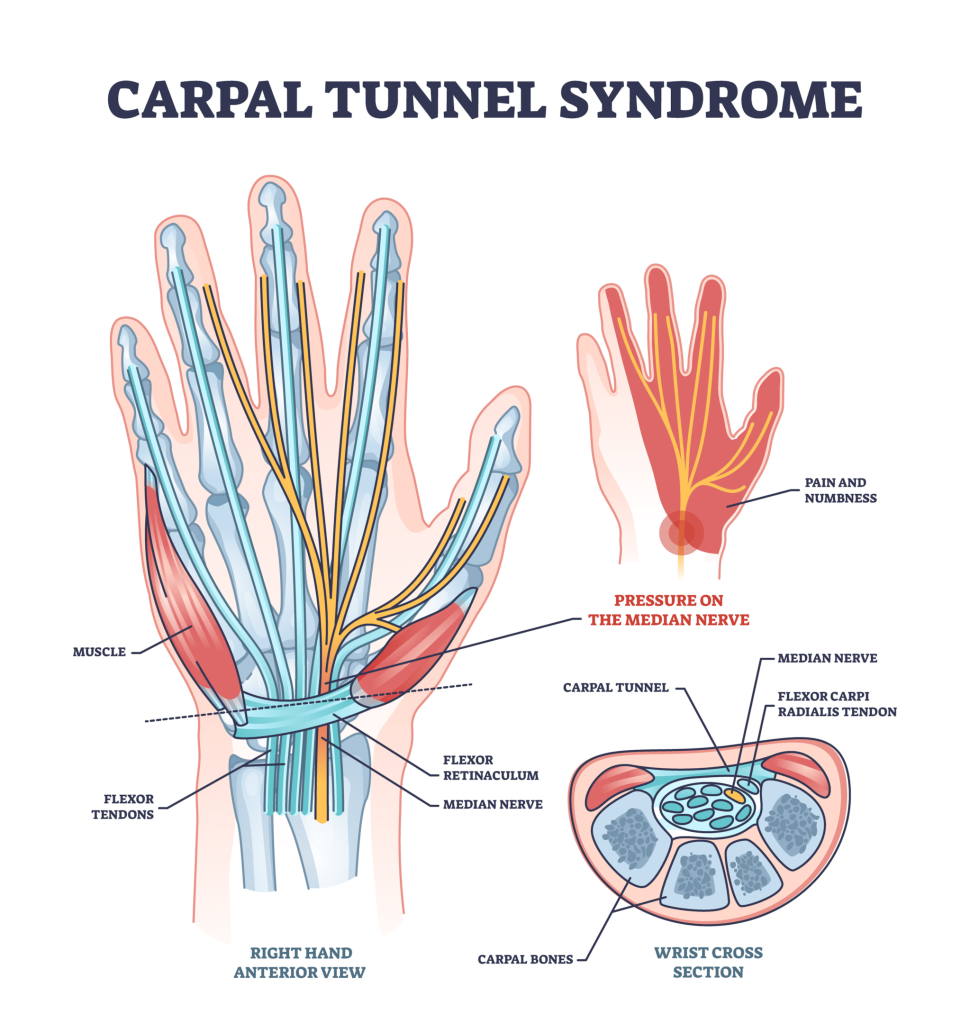
Carpal Tunnel Syndrome (CTS), a prevalent nerve disorder, affects the hand and wrist, causing discomfort and hindering daily activities. It occurs when the median nerve, traversing through the wrist’s carpal tunnel, gets compressed. This condition leads to symptoms like pain, numbness, and tingling in the hand, affecting millions globally. Its impact on everyday life is significant, disrupting sleep, work, and routine tasks. Understanding CTS’s effects is vital for recognizing the importance of effective treatment options that restore functionality and comfort.
👉Also Read: Where Does It Hurt? Why an Orthopedic Doctor Asks These Questions
Understanding the Patient-First Approach at Academy Orthopedics
At Academy Orthopedics, we embody a patient-first approach, prioritizing individual needs and experiences in our care. Our philosophy is centered around understanding each patient’s unique journey with Carpal Tunnel Syndrome, ensuring that treatments are not just effective, but also empathetically tailored to their lifestyle and concerns. This commitment to personalized care stems from a deep understanding that each case of CTS is as unique as the individual experiencing it.
We recognize that the path to comfort and functionality varies from person to person. Therefore, our treatments are designed to adapt to each patient’s specific symptoms and circumstances. This could mean different therapeutic approaches, varying levels of intervention, or customized recovery plans.
Diagnosis and Assessment of Carpal Tunnel Syndrome

Diagnosing Carpal Tunnel Syndrome (CTS) early is crucial for effective treatment and long-term relief. The initial step in this process involves recognizing the early signs and symptoms of carpal tunnel. Common indicators include numbness, tingling, or pain in the thumb, index finger, middle, and ring fingers, often worsening at night. Some individuals may experience a sensation akin to an electric shock in these fingers or a weakness in the hand, affecting grip strength and agility.
A comprehensive medical history and physical examination form the cornerstone of CTS diagnosis. During the medical history review, factors such as prior injuries, daily activities, and existing health conditions that may contribute to CTS are evaluated. This is followed by a physical examination, focusing on the hands, arms, shoulders, and neck to identify any signs of nerve pressure or damage.
Special attention is given to the median nerve, which passes through the carpal tunnel in the wrist. Tests may include tapping or pressing on the nerve (Tinel’s sign) or holding the middle fingers and wrists in a flexed position (Phalen’s test) to reproduce symptoms.
These diagnostic steps are vital in not only confirming the presence of Carpal Tunnel Syndrome but also in ruling out other conditions with similar symptoms, ensuring accurate and targeted treatment strategies. When carpal tunnel syndrome is diagnosed, a personalized treatment plan, will be recommended to restore wrist strength and alleviate symptoms.
Personalized Treatment Options at Academy Orthopedics
At Academy Orthopedics, we understand that each case is unique, which is why we offer personalized, non-surgical treatment options to treat Carpal Tunnel Syndrome. Our approach includes the use of a wrist splint, designed to immobilize the wrist, especially during the night to alleviate pressure on the median nerve and develop carpal tunnel syndrome. Additionally, we prescribe nonsteroidal anti-inflammatory drugs (NSAIDs) to reduce inflammation and relieve pain.
Surgical Interventions for Severe Cases
For more severe cases of Carpal Tunnel Syndrome where non-surgical methods are insufficient, surgical intervention becomes necessary. The primary surgical procedure is carpal tunnel release surgery, which aims to relieve pressure on the median nerve. There are two main types of carpal tunnel release surgery: open surgery and endoscopic surgery.
Open carpal tunnel surgery involves an incision in the palm, offering direct visibility and access to the carpal tunnel. Endoscopic surgery, on the other hand, is less invasive, using smaller incisions and a camera to guide the procedure. Both methods are effective, with faster recovery times.
Postoperative Care and Rehabilitation
After the surgery, patients receive guidance on postoperative care and rehabilitation:
Frequent Rest Breaks: Taking regular breaks from repetitive activities is crucial to prevent wrist injuries, overuse, and strain on the wrist.
Wrist Positioning: Maintaining proper wrist positioning and avoiding extremes of flexion and extension during wrist pain is essential for the healing process.
Wrist braces provide support and stability during the early stages of recovery.
Long-Term Management and Prevention Strategies
Managing CTS is an ongoing process, requiring lifestyle adjustments to reduce the risk factors of recurrence. Patients are educated about:
Lifestyle Adjustments: Making ergonomic changes at workstations and adopting healthy habits can help prevent CTS from returning.
Frequent Breaks and Wrist Straightening Exercises: Taking regular breaks to rest the hands and performing wrist straightening exercises can reduce the risk of developing CTS.
Emphasizing Compassionate Care and Support
At the core of our approach to treating Carpal Tunnel Syndrome at Academy Orthopedics is compassionate care and support. We believe in cultivating empathy, not just through advanced treatments, but also by sharing patient testimonials and success stories. These narratives offer hope and understanding, reinforcing that patients are not alone in their journey.
Our orthopedic surgeons play a pivotal role in providing emotional support, and understanding that healing extends beyond physical relief. They connect with patients personally, offering encouragement and reassurance, and ensuring that every individual feels heard, valued, and understood throughout their treatment and recovery process.
Collaborative Approach to Holistic Wellness
A collaborative approach that emphasizes holistic wellness proves crucial. This method incorporates physical therapy and connective tissue exercises, integral in managing the condition. Physical therapy plays a significant role in improving mobility and strength, while exercises targeting connective tissues help alleviate pressure on the median nerve.
Holistic wellness, which considers the individual’s overall well-being, is vital in the long-term management of CTS. It ensures that treatment is not just about relieving symptoms but also about promoting overall hand and wrist health, preventing future complications, and improving quality of life.
👉Also Read: Understanding Tendonitis in the Hand: Causes, Symptoms, and Treatment Options
Personalized Care for Lasting Relief from Carpal Tunnel Syndrome at Academy Orthopedics
At Academy Orthopedics, we empower individuals to alleviate symptoms, restore comfort, and enhance their quality of life through a personalized and patient-centric approach to treating Carpal Tunnel Syndrome (CTS). We strongly advocate for early intervention for those experiencing CTS symptoms, urging them to explore tailored treatment options. Your well-being is our foremost priority, and we are dedicated to guiding you toward lasting comfort.
With empathy at the core of our approach, we aim to enhance your overall quality of life and provide sustained relief from Carpal Tunnel Syndrome symptoms. Please don’t hesitate to reach out by calling us or conveniently scheduling an appointment.
